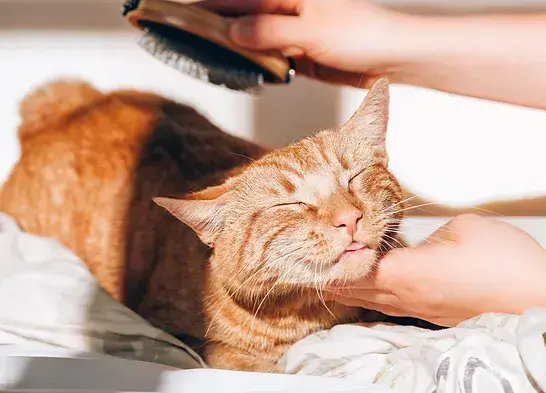
It’s well known that our feline friends are very autonomous by nature. They not only have tremendous survival instincts, but also have a physiology that gives them everything they need to groom themselves and keep looking their best.
The question is therefore legitimate: is grooming your cat really necessary?
The answer is yes, as there are many benefits! In addition to keeping an eye on your cat's health and checking for anomalies such as wounds, unusual bumps or ticks, grooming your cat can also be great quality time with your beloved friend.
If you’re looking to get involved with your cat’s grooming but aren't sure what to do, we've put together for you this grooming 101.
Bath time
Has your cat conveniently stepped in a mud puddle or accidently been sprayed by a skunk? Did you notice an insect on their coat? Then it's probably time for the dreaded bath!
We recommend using products specially adapted for your feline, such as our Pür shampoos and conditioners. They're therapeutic, versatile and very gentle on your kitty.
If your cat hates to get wet or if you're not too keen on getting a bit of water sprayed around the bath, we suggest you try a dry shampoo. It's a quick, no-rinse solution that moisturizes the skin and coat while soothing dry, itchy skin.
Brushing
It's also beneficial to brush long-haired cats regularly. This small gesture can help remove dirt, grease, tangles and dead hair from the coat, as well as promote sebum and blood circulation, improving the overall condition of the skin.
When the air is dry, like in winter months, your cat can build up an electrical charge in its thick coat. To avoid the formation of large knots or receiving a static shock that will send him flying into the other room, we recommend brushing your companion with our famous Cat Gläm anti-static.
Trimming the claws
Whether it's for their own well-being or that of your furniture, it's a good idea to get your feline used to having their claws trimmed.
If you have the know-how (and courage) to perform this task, you'll first need to get a good claw clipper. Also, make sure your cat is nice and calm before you begin. Most cats have light-coloured claws, which makes it easy to see the blood vessels and nerves as a pink band at the base of the nail, called the quick. You must cut the claw to within about two millimeters of the quick, otherwise you could cut into a nerve!
Cleaning the ears
Cats have a reputation for being clean, but sometimes they need a little help with hard-to-reach places, like their ears. If you notice wax, dirt or other debris clogging their ears, it's time to clean them!
You'll need an ear cleaner for cats like our lavender hydrolate, which you can apply with a damp cotton ball. Simply wipe off any wax or dirt carefully.
Conclusion
We hope to have enlightened you a little more on the subject. Don't hesitate to leave us your questions or thoughts in the comments!
